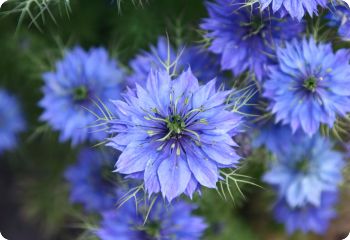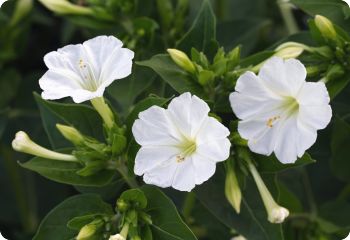Self-Sowing Annuals
by Diane Linsley
What are the best self-sowing annuals?
Many years ago, I went on a tour of a place that the locals affectionately (or jealously) refer to as "the castle". I was shocked by the profuse display of perennials - thousands of dollars worth! Planted en masse! It was nothing like my own garden, where I had one of each perennial, spaced far apart.
At that point, I realized just how many plants it takes to make a great garden. I also realized, unhappily, that my own garden would never look like that. I simply couldn't afford it. In spite of my crushed hopes, I continued to collect perennials whenever I had a few dollars. Then something happened that forever changed the way I gardened. I discovered self-sowing annuals.
Don't ask me why I never tried them before. Maybe it's because I wanted to follow the advice in all those gardening books that extoll the virtues of perennials. Now, don't get me wrong. I love perennials! I can't imagine a garden without them. But when you want to cover lots of ground in a short amount of time on a skinny budget, there's nothing like self-sowing annuals.
Like perennials, self-sowing annuals come back every year, but from seeds instead of roots. But they're not as predictable as perennials. They come up wherever they choose, sometimes in a distant part of the yard. Sometimes they come back in excess, and sometimes not at all. If a perennial is like a faithful dog, then a self-sowng annual is like a finicky, independent cat. Maybe that's why I like them - I'm a cat person. I like how my cat doesn't require too much attention, and I repect her independence.
But, as with all things in life, there are problems with independent cats - I mean plants. It seems like they fall into one of two categories: (1) those that don't return reliably, especially in heavily mulched gardens, and (2) those that return in such force that they become a thinning nightmare. The unpredictability can drive a control freak insane!
How do you solve this dilemma? How about giving up the illusion of control? That's a challenge for this gardener who uses a yard stick to space her plants properly. But it helps if I refer to my garden as "the cottage garden" instead of "the perennial border".
Now that the disadvantages of self-sowing annuals are out of the way, we can talk about the benefits.
4 Reasons to Grow Self-Sowing Annuals
1. They're cheap.
2. They fill in the gaps between perennials and make your garden look lush.
3. If you don't like them, you can pull them up before they go to seed.
4. Did I mention that they're cheap?
One of the most common questions that people ask me about self-sowing annuals is, "Why can't I just sow the seeds in the fall and have lots of flowers the following summer?"
Here's my reply: You can do that with some annuals, but it doesn't work with everything. The more finicky ones need warm temperatures to germinate. They are best started indoors the first year, or sown outdoors after the last frost date in spring. The reason why they still manage to reseed in the garden is because they make millions of seeds. Some of the seeds are bound to survive the winter and bloom the following year. But you're not getting millions of seeds in a packet, so please don't waste them by sowing the seeds at the wrong time. Follow the directions on the packet.
Here's a list of the best self-sowing annuals in my zone 5 garden. I don't know how they will perform in your garden. You'll never know until you try.
Best Self-Sowing Annuals
Alyssum - Masses of tiny white, pink or purple flowers. Self-sowing filler.
Amaranth - Self-sown seedlings are great for soups & salads.
Balsam 'Camellia Flowered' - Shade-tolerant annual in a mix of colors.
Calendula - Yellow, orange or apricot flowers. Reseeds nicely.
California Poppy - Self-sowing annual in a wide range of colors.
Centaurea cyanus - Reliable reseeder in a variety of colors.
Clarkia amoena - Native wildflower. Makes a good self-sowing bulb cover.
Cleome - Tall, late summer-blooming annual. Reseeds in moderation
Cosmos sulphureus - Self sows better than Cosmos bipinnatus.
Cynoglossum amabile - Indigo-blue flowers in summer. Self-sows lightly.
German Chamomile - Small, daisy-like flowers make a nice filler. Tea herb.
Gilia tricolor - Native wildflower. Chocolate fragrance. Self sows lightly.
Larkspur - Tall spikes of purple, blue, lavender, pink, rose and white flowers.
Lavatera trimestris - Large, cup-shaped, pink or white flowers.
Linaria maroccana - Tiny, snapdragon-like flowers. Reliable self-sower in pots.
Linum grandiflorum - Scarlet-red, salmon or white flowers with a silky sheen.
Mirabilis jalapa - Fragrant, trumpet-shaped flowers. Reliable reseeder.
Monarda citriodora - Native annual. Attracts hummingbirds and butterflies.
Morning Glory - Ipomoea purpurea is the best self-sowing morning glory.
Nemophila - Blue, white or purple flowers. Great bulb cover. Good self-sower.
Nicotiana - Fragrant, trumpet-shaped flowers in several colors.
Nigella damascena - Easy to grow. Heavy self sower that makes a good filler.
Poppy - Papaver rhoeas reseeds better than Papaver somniferum.
Rudbeckia hirta - Daisy-like flowers in shades of yellow to mahogany red.
Snapdragon - Fun to grow. Comes in a wide range of colors.
Viola - Makes a nice groundcover between larger plants.
Related Articles
First-Year Flowering Perennials - Get more bang for your buck.
Flowers for Hummingbirds - The best flowers for attracting hummingbirds.
Shade-Tolerant Flowers - Annuals and perennials for difficult shady spots.
Recommended Books
Tasha Tudor's Garden by Tova Martin and Richard W. Brown
The Bold and Brilliant Garden by Sarah Raven
Seeds

